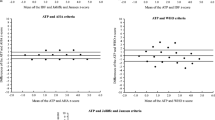Abstract
Objectives
The aim of this study was to compare the effectiveness of IDF (International Diabetes Federation) and ATP-III (National Cholesterol Education Program-Adult Treatment Panel III) for predicting metabolic syndrome, and to evaluate the usefulness of these definitions for health promotion.
Design
A cross-sectional study.
Setting
A national random sample.
Participants
A population representative sample of 1021 54–91 year-old Taiwanese.
Measurements
Subjects were measured for anthropometric and biochemical indicators and rated for the presence of metabolic syndrome using the two definitions. We evaluated the effectiveness of the two definitions in predicting MetS among those who had specific metabolic disorders. Results were analyzed with Student t-test and McNemar’s test.
Results
Among the 918 subjects who had one or more MetS-item disorders, ATP-III rated greater proportions of subjects as having MetS than IDF, but both definitions predicted less than 50% (37.7% and 45.4%, respectively) as having MetS.
Conclusion
Compared to IDF, ATP-III rated a greater proportion of subjects as having MetS, but both definitions missed more than 50% of subjects who had metabolic disorder(s). Since those who are missed have as much need for lifestyle intervention, the definitions appear not appropriate for health promotion.
Similar content being viewed by others
References
Reaven GM. Banting lecture 1988. Role of insulin resistance in human disease. Diabetes. 1988;37(12):1595–1607.
Grundy SM, Cleeman JI, Daniels SR, Donato KA, Eckel RH, Franklin BA, et al. Diagnosis and management of the metabolic syndrome: an American Heart Association/National Heart, Lung, and Blood Institute Scientific Statement. Circulation. 2005;112(17):2735–2752.
Alberti KG, Zimmet P, Shaw J. Metabolic syndrome—a new world-wide definition. A Consensus Statement from the International Diabetes Federation. Diabet Med. 2006;23(5):469–480.
Hwang LC, Bai CH, Chen CJ. Prevalence of obesity and metabolic syndrome in Taiwan. J Formos Med Assoc. 2006;105(8):626–635.
Hermalin AL, Liang J, Chang MC. 1989 survey of the health and living status of the elderly in Taiwan: questionnaire and survey design. Comparative study of the elderly in Asia research report 89-1. Ann Arbor: University of Michigan.; 1989.
Seeman T, Glei D, Goldman N, Weinstein M, Singer B, Lin YH. Social relationships and allostatic load in Taiwanese elderly and near elderly. Soc Sci Med. 2004;59(11):2245–2257.
Goldman N, Lin IF, Weinstein M, Lin YH. Evaluating the quality of self-reports of hypertension and diabetes. J Clin Epidemiol. 2003;56(2):148–154.
Cheng TY, Wen SF, Astor BC, Tao XG, Samet JM, Wen CP. Mortality risks for all causes and cardiovascular diseases and reduced GFR in a middle-aged working population in Taiwan. Am J Kidney Dis. 2008;52(6):1051–1060.
Lee J, Ma S, Heng D, Tan CE, Chew SK, Hughes K, et al. Should central obesity be an optional or essential component of the metabolic syndrome? Ischemic heart disease risk in the Singapore Cardiovascular Cohort Study. Diabetes Care. 2007;30(2):343–347.
Moy FM, Bulgiba A. The modified NCEP ATP III criteria maybe better than the IDF criteria in diagnosing Metabolic Syndrome among Malays in Kuala Lumpur. BMC Public Health. 2010;10:678.
Tong PC, Kong AP, So WY, Yang X, Ho CS, Ma RC, et al. The usefulness of the International Diabetes Federation and the National Cholesterol Education Program’s Adult Treatment Panel III definitions of the metabolic syndrome in predicting coronary heart disease in subjects with type 2 diabetes. Diabetes Care. 2007;30(5):1206–1211.
Moebus S, Hanisch JU, Aidelsburger P, Bramlage P, Wasem J, Jockel KH. Impact of 4 different definitions used for the assessment of the prevalence of the Metabolic Syndrome in primary healthcare: The German Metabolic and Cardiovascular Risk Project (GEMCAS). Cardiovasc Diabetol. 2007;6:22.
Santos AC, Barros H. Impact of metabolic syndrome definitions on prevalence estimates: a study in a Portuguese community. Diab Vasc Dis Res. 2007;4(4):320–327.
Wang J, Ruotsalainen S, Moilanen L, Lepisto P, Laakso M, Kuusisto J. The metabolic syndrome predicts cardiovascular mortality: a 13-year follow-up study in elderly non-diabetic Finns. Eur Heart J. 2007;28(7):857–864.
Guembe MJ, Toledo E, Barba J, Martinez-Vila E, Gonzalez-Diego P, Irimia P, et al. Association between metabolic syndrome or its components and asymptomatic cardiovascular disease in the RIVANA-study. Atherosclerosis. 2010;211(2):612–617.
Thomas F, Pannier B, Benetos A, Vischer UM. The impact of the metabolic syndrome — but not of hypertension — on all-cause mortality disappears in the elderly. J Hypertens. 2011;29(4):663–668.
He Y, Jiang B, Wang J, Feng K, Chang Q, Zhu S, et al. BMI versus the metabolic syndrome in relation to cardiovascular risk in elderly Chinese individuals. Diabetes Care. 2007;30(8):2128–2134.
Hata J, Doi Y, Ninomiya T, Fukuhara M, Ikeda F, Mukai N, et al. Combined effects of smoking and hypercholesterolemia on the risk of stroke and coronary heart disease in Japanese: the Hisayama study. Cerebrovasc Dis. 2011;31(5):477–484.
Arboix A, Garcia-Eroles L, Oliveres M, Targa C, Balcells M, Massons J. Pretreatment with statins improves early outcome in patients with first-ever ischaemic stroke: a pleiotropic effect of statins or a beneficial effect of hypercholesterolemia? BMC Neurol. 2010;10:47.
Succurro E, Marini MA, Arturi F, Grembiale A, Fiorentino TV, Andreozzi F, et al. Usefulness of Hemoglobin A1c as a Criterion to Define the Metabolic Syndrome in a Cohort of Italian Nondiabetic White Subjects. Am J Cardiol. 2011(170):1650–1655.
Ravikiran M, Bhansali A, Ravikumar P, Bhansali S, Dutta P, Thakur JS, et al. Prevalence and risk factors of metabolic syndrome among Asian Indians: a community survey. Diabetes Res Clin Pract. 2010;89(2):181–188.
Simmons RK, Alberti KG, Gale EA, Colagiuri S, Tuomilehto J, Qiao Q, et al. The metabolic syndrome: useful concept or clinical tool? Report of a WHO Expert Consultation. Diabetologia. 2010;53(4):600–605.
Lewis SJ, Rodbard HW, Fox KM, Grandy S. Self-reported prevalence and awareness of metabolic syndrome: findings from SHIELD. Int J Clin Pract. 2008;62(8):1168–1176.
Author information
Authors and Affiliations
Corresponding author
Rights and permissions
About this article
Cite this article
Chen, M.M., Tsai, A.C. The effectiveness of IDF and ATP-III in identifying metabolic syndrome and the usefulness of these tools for health-promotion in older Taiwanese. J Nutr Health Aging 17, 413–416 (2013). https://doi.org/10.1007/s12603-012-0440-2
Received:
Accepted:
Published:
Issue Date:
DOI: https://doi.org/10.1007/s12603-012-0440-2




